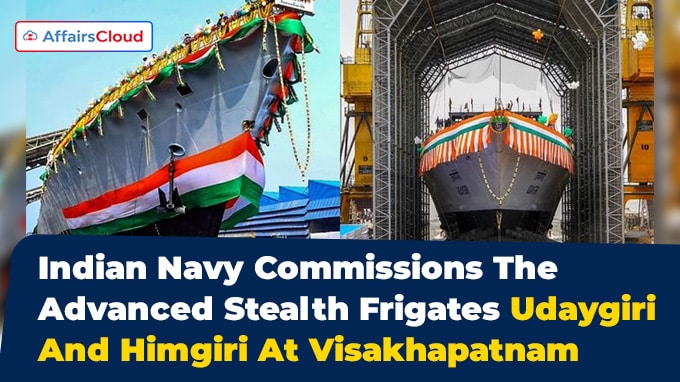 In August 2025, Indian Navy (IN) commissioned two state-of-the-art stealth frigates, ‘Indian Naval Ship (INS) Udaygiri (Yard 12652)’ and ‘INS Himgiri (Yard 3022)’, at Eastern Naval Command (ENC) in Visakhapatnam, Andhra Pradesh (AP).
In August 2025, Indian Navy (IN) commissioned two state-of-the-art stealth frigates, ‘Indian Naval Ship (INS) Udaygiri (Yard 12652)’ and ‘INS Himgiri (Yard 3022)’, at Eastern Naval Command (ENC) in Visakhapatnam, Andhra Pradesh (AP).
- The commissioning of these stealth frigates was presided by the Union Minister Rajnath Singh, Ministry of Defence (MoD). It also marked the 1st ever simultaneous commissioning of two warships constructed at different shipyards.
Exam Hints:
- What? Commissioning of two new Stealth Frigates
- Presided by: Union Minister Rajnath Singh, MoD
- Where? Eastern Naval Command (ENC) at Visakhapatnam(AP)
- Ships Name: INS Udaygiri (2nd ship from Project 17A) and INS Himgiri (3rd ship from Project 17A)
- Built by: INS Himgiri by GRSE and INS Udaygiri by MDL
- Designed by: IN’s Warship Design Bureau (WDB)
- Indigenous Content: 75%
About INS Udaygiri and INS Himgiri:
Variant: Both Udaygiri and Himgiri are variant vessels of the Project 17 (Shivalik) class frigates.
Legacy of the Name: Both newly commissioned vessels are named after previous versions of INS Udaygiri (F35) and INS Himgiri (F34) that served the nation from 1976 to 2007 and from 1974 to 2005, respectively.
Constructed by: INS Udaygiri, the 2nd ship from Project 17A stealth frigates, was constructed by Mazagon Dock Shipbuilders Limited (MDL).
- While, INS Himgiri, the 3rd ship of Project 17A ship and also the 1st ship of this series which was constructed by Garden Reach Shipbuilders & Engineers (GRSE).
Designed by: Both frigates were designed in-house by the IN’s Warship Design Bureau(WDB). These are the 100th and 101st warships designed in-house by the WDB, which marks the significant milestone in 50 years of indigenous warship design.
Induction into Eastern Fleet: The two frigates, following ‘INS Nilgiri’, the lead ship of the successor class to Project 17 (Shivalik-class), were inducted into the Eastern Fleet, strengthening India’s capability to safeguard its maritime interests across the Indian Ocean Region (IOR).
Key Specifications: These vessels have the capacity to displace about 6,700 tonnes i.e. nearly 5% more than their predecessors; and maximum speed of 28 knots or, 52 kilometres per hour (kmph) with range exceeding 5,500 nautical miles.
Armaments: These vessels also feature a wide range of advanced weapons such as: supersonic surface-to-surface missiles; medium range surface-to-air missiles; 76 millimeter (mm) MR Gun and a combination of 30 mm and 12.7 mm close-in weapon systems.
- Propulsion System:It is also equipped with a Combined Diesel or Gas (CODOG) propulsion system that drives a Controllable Pitch Propeller (CPP) on each shaft; and a state-of-the-art Integrated Platform Management System.
- Sensors & Radars: Features the MF-STAR (Multi-Function Surveillance, Tracking and Acquisition Radar) AESA radar, BEL (Bharat Electronics Limited)’s HUMSA-NG (Hull Mounted Sonar Array – Next Generation) sonar, the Ajanta Electronic Warfare (EW) system, and the CMS-17A (Combat Management System – Project 17A).
- Aircrafts: Can operate MH-60R (Romeo) helicopters, ALH (Advanced Light Helicopter) Dhruv Mk-II, or Sea King helicopters.
Local Content: These frigates with nearly 75% of indigenous content, are in alignment with the Government of India (GoI)’s vision of Aatmanirbhar Bharat (Self-Reliance) in defence manufacturing.
About Project 17 Alpha frigates (P-17A):
Target: To construct 7 warships and frigates for the IN.
Construction: Of the 7 warships, 3 are being built by GRSE and the remaining 4 are being built by MDL
1st frigate : INS Nilgiri, constructed by MDL, was delivered to IN in December 2024.
About Indian Navy (IN):
Chief of Naval Staff (CoNS)- Admiral Dinesh Kumar (DK) Tripathi
Headquarters- New Delhi, Delhi
Founded- 1950




